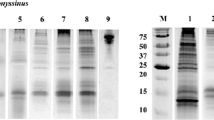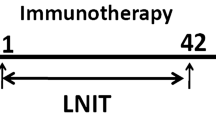Abstract
Mites are among the major sources of domestic and occupational allergens worldwide, and continuous exposure to these allergens leads to chronic airway inflammation. One of the most allergenic species is the storage mite Tyrophagus putrescentiae (Schrank). Protein extracts are produced from this mite for tests that help the clinical diagnosis (via prick test), treatment, and monitoring of disease progression in patients who had positive results for allergic reactions. Therefore, the aim of the present study was to evaluate the cell viability of RAW 264.7 and L929 cells when exposed to in-house raw protein extracts of T. putrescentiae compared to a commercial product, as well as quantify TNF-α secretion by RAW 264.7. Additionally, this study quantified the effect of these extracts in IgE secretion in total blood of people affected by this mite. The study found similarity between the in-house extract and the commercial extract as they had equivalent TNF-α secretion. Additionally, viabilities of RAW 264.7 and L929 exposed to the in-house extract were compatible with viabilities of cells exposed to the commercial extract, with no cytotoxicity at the concentrations tested. Results corroborated the hypothesis that the extract produced in-house would be equivalent to the commercial extract in allergic patients when the IgE was quantified. This study is the first to show the cytotoxicity of T. putrescentiae extracts, and to provide a quantitative analysis of TNF-α and IgE.





Similar content being viewed by others
Change history
03 August 2023
Copyright holder name corrected.
References
Abbas AK, Lichtman AH (2003) Cellular and Molecular Immunology. Quinta edição, Filadélfia, Saunders
Abbas AK, Pillai S, Lichtman AH (2019) Imunologia: Celular e Molecular. 9 ed. Rio De Janeiro: Editora Elsevier Ltda, 2019
Arlian L, Geis D, Vyszenski-Moher D, Bernstein I, Gallagher J (1984) Antigenic and allergenic properties of the storage mite tyrophagus putrescentiae. J Allergy Clin Immunol 74:166–171
Bauer TT, Montón C, Torres A, Cabello H, Fillela X, Maldonado A, Nicolás JM, Zavala E (2000) Comparison ofsystemic cytokine levels in patients with acute respiratory distress syndrome, severe pneumonia, and controls.Thorax 55:46–52
Bernatowicz P, Pampuch A, Zywno H, Kowal K (2022) Effect of Dermatophagoides pteronyssinus extract on the expression of genes involved in inflammation and tissue remodeling by peripheral blood mononuclear cells of allergic asthma patients. Adv Med Sci 67:234–240
Bravo CM, Ortiz IL, Soto AO, Vazquez RG (1999) Allergy to storage mites. Allergy 54:769–770
Calderón MA, Linneberg A, Kleine-Tebbe J, De Blay F, De Rojas DHF, Virchow JC et al (2015) Respiratory allergy caused by house dust mites: what do we really know? J Allergy Clin Immunol 136:38–48
Colloff MJ (2009) Dust mites. CSIRO Publishing, Springer, Collingwood, Dordrecht
Elder BL, Morgan MS, Arlian LG (2012) Effect of stored product mite extracts on human dermal microvascular endothelial cells. J Med Entomol 49:1411–1418
Fish JE, Peters SP (1999) Airway remodeling and persistent airway obstruction in asthma. J Allergy Clin Immunol 104:509–516
Gasparrini A, Guo Y, Sera F, Vicedo-Cabrera AM, Huber V, Tong S et al (2017) Projections of temperature-related excess mortality under climate change scenarios. Lancet Planet Health 1:e360–e367
Hage-Hamsten MV, Johansson E (1998) Clinical and immunologic aspects of storage mite allergy. Allergy 53:49–53
Hossny E, El-Sayed S, Abdul-Rahman N (2014) Sensitivity to Five Types of House Dust Mite in a Group of Allergic Egyptian Children. Pediatric Allergy, Immunology, and Pulmonology 27:133–137
Hughes AM (1976) The mites of stored food and houses. In: Ministry of Agriculture, Fisheries and Food Technical Bulletin, 9. Her Majesty’s Stationery Office, London.
Jeon SJ, Kim EJ, Oh J, Yun CY (2020) Tyrophagus putrescentiae induces inflammatory cytokine secretions from the human cell lines THP-1 and EoL‐1 cells. Entomol Res 50:361–368
Jeong KY, Hong CS, Yong TS (2007) Domestic arthropods and their allergens. Protein Pept Lett 14:934–942
Jeong KY, Lee H, Lee JS, Lee J, Lee IY, Ree HI, Hong CS, Yong TS (2007) Molecular cloning and the allergeniccharacterization of tropomyosin from Tyrophagus putrescentiae. Protein Pept Lett 14: 431–436.
Liao E, Ho C, Yin S, Tsai J (2013a) Immune responses to Tyrophagus putrescentiae-Induced Airway inflammation in mice. J Investig Allergol Clin Immunol 23:20–29
Liao EC, Lin YH, Chiu CL, Lin TC, Tsai JJ (2013b) Identification of allergenic component tyr p 8 from Tyrophagus putrescentiae and cross-reactivity with derp 8. Clin Vaccine Immunol 20:506–512
Merly L, Smith SL (2017) Murine RAW 264.7 cell line as an immune target: are we missing something? Immunopharmacol Immunotoxicol 39:55–58
Meza MDL, Afanador TR, Guzmán AL, Egea GG, Bermejo EE (2011) Caracterización de la actividad alergénica y enzimática de extractos somáticos producidos a partir de cultivos in vitro del ácaro dermatophagoides farinae. Revista Científica Salud Uninorte 27(1)
Moraes LS, Barros MD, Takano OA, Assami NM (2001) Fatores de risco, aspectos clínicos e laboratoriais da asma em crianças. J Pediatr 77:447–454
Navarro JM, Meza DLM, Bermúdez DM (2008) Identificación de ácaros del polvo casero en colchones y almohadas de niños alérgicos de Santa Marta, Colombia. Duazary 5:1.
Nuñez NK, Da Cunha AA, Dutra MS, Barbosa GL, Morassutti AL, De Souza RG, Vargas MHM, Antunes GL, Silveira JS, Silva GL, Pitrez PM (2016) Acute and chronic exposure to Tyrophagus putrescentiae induces allergic pulmonary response in a murine model. Asia Pac Allergy 6:48–55
Pereira EA, Silva DAO, Cunha-Júnior JP, Almeida KC, Alves R, Sung SJ, Taketomi EA (2005) IgE, IgG1, and IgG4 antibody responses to Blomia tropicalis in atopic patients. Allergy 60:401–406
Suárez-Gutiérrez M, Macías-Garza JE, López-Ortiz DJ, Fuentes B, Álvarez-Cardona A (2019) Sensibilização a aeroalérgenos en pacientes con rinitis alérgica en Aguascalientes, M?xico. Revista Alergia Mexico 66: 388–393
Yu SJ, Liao EC, Tsai JJ (2014) House dust mite allergy: environment evaluation and disease prevention. Asia Pac Allergy 4:241–252
Acknowledgements
The authors are grateful to Universidade do Vale do Taquari - Univates and FAPERGS (21/2551-0000083-0) for their financial support, scholarships and for providing the material required to conduct this study. We thank Mrs. Daniela Tannus for improving the English of the manuscript.
Funding
This work was supported by the FAPERGS under Grant 21/2551-0000083-0.
Author information
Authors and Affiliations
Contributions
All authors contributed to the study conception and design, material preparation, data collection and analyses. All authors read and approved the final manuscript.
Corresponding author
Ethics declarations
Conflict of interest
The author(s) declared no potential conflicts of interest with respect to the research, authorship, and/or publication of this article.
Additional information
Publisher’s Note
Springer Nature remains neutral with regard to jurisdictional claims in published maps and institutional affiliations.
Rights and permissions
Springer Nature or its licensor (e.g. a society or other partner) holds exclusive rights to this article under a publishing agreement with the author(s) or other rightsholder(s); author self-archiving of the accepted manuscript version of this article is solely governed by the terms of such publishing agreement and applicable law.
About this article
Cite this article
Damo, L.H., Ribeiro, L.A.N., Vieira, L. et al. Effects of in-house and commercial extracts of the allergenic mite Tyrophagus putrescentiae on murine and human cell responses. Exp Appl Acarol 90, 33–45 (2023). https://doi.org/10.1007/s10493-023-00801-7
Received:
Accepted:
Published:
Issue Date:
DOI: https://doi.org/10.1007/s10493-023-00801-7




